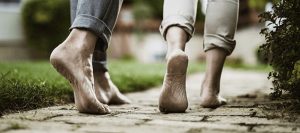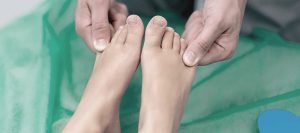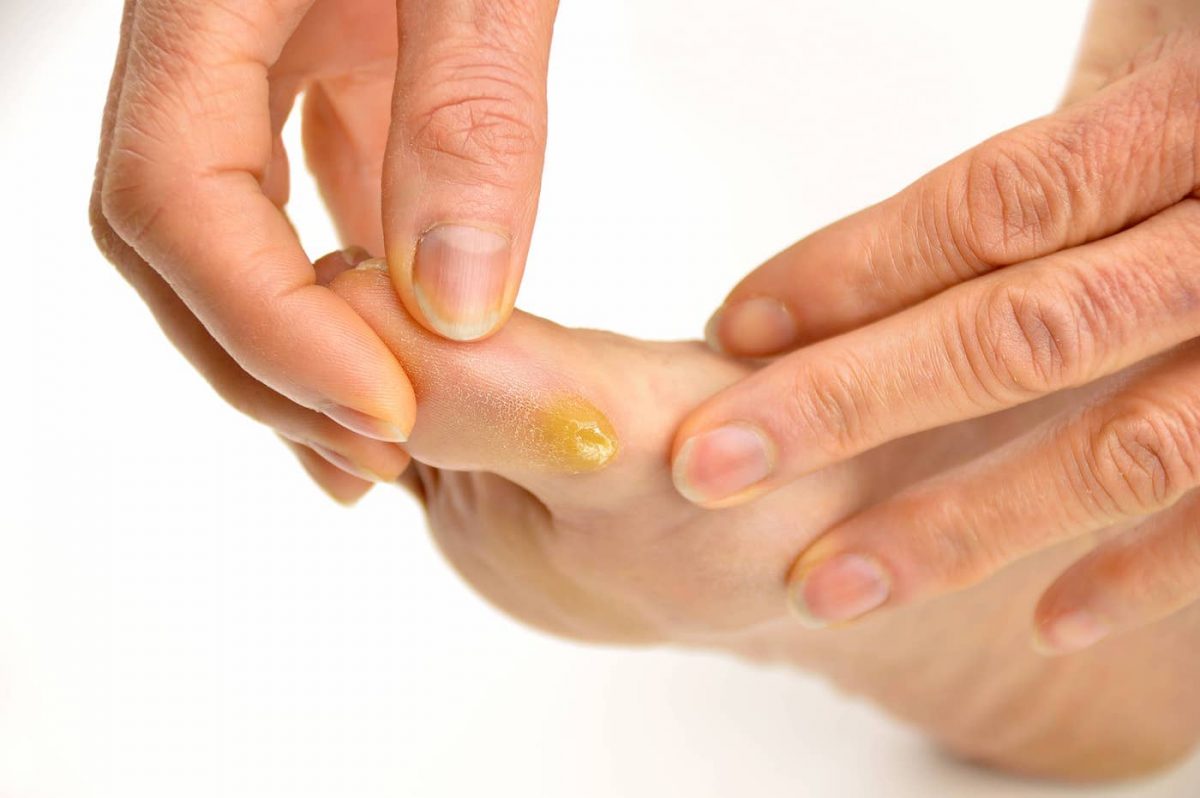
A callus is a thickened layer of compressed skin cells that form as a result of the repeated pressure on the feet that occurs from the thousands of steps we take every single day of our lives.
Known as a tyloma in podiatry, a callus is most commonly found beneath the metatarsal head and may or may not be painful.
The Two Basic Types Of Calluses
There are two basic types; namely, the discrete nucleated callus and the diffuse shearing callus.
The former is a painful lesion that forms as a bump on the skin, is confined to one particular area of the foot and contains a keratin plug.
This is a small bump created by tiny skin follicles, which become clogged with dead skin cells and a protein known as keratin.
The diffuse-shearing callus appears as a contusion on the skin that measures more than one centimeter across. It is the result of shearing (cutting) force, and unlike its counterpart, does not contain a keratin plug.
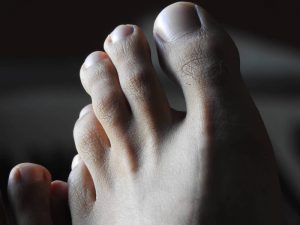
What Exactly Causes Calluses To Form?
A callus can arise from numerous causes such as:poorly fitting shoes or frequently walking barefoot.
Its occurrence is the result of a process known as hyperkeratinization, which is a thickening of the outer layer of skin that is made of keratin, a naturally-occurring protein that renders the skin waterproof and protects it from ultra violet light, bacteria and many toxic chemicals. Extra layers of keratin grow as the skin’s natural reaction to constant pressure or friction in one spot and they are known to cause some pain.
Is It A Callus Or A Corn?
Understanding the similarities and differences between callouses and painful cousins; namely, corns, can help sufferers seek appropriate treatment and preventive measures for long term management and foot health.
Both conditions are caused by extreme pressure and friction and differences can best be ascertained by their appearance, feel and where they are located.

Corns are found on the tops and sides of the toes as well as in between them, while callouses only form on weight-bearing areas including: the balls, heels and soles of the feet.
Corns are yellow or grayish in color, small and either circular or oval in shape with a bump or cone-shaped center.
They are often more painful than callouses because of the pressure they exert on the raised area.
Callouses are larger, more uneven in shape and cover a wider surface area of the skin. Texture is much smoother and they do not have a central core.
How Exactly Do Calluses Occur?
Hands as well as feet develop calluses from lifting heavy weights; excessive writing with a pen or pencil or using hand tools.
Calluses on the feet arise from activities such as: running long distances; walking barefoot on hard surfaces; obesity; loose shoes that rub against the shoe’s seam, high heels and tight or narrow foot wear. Medical conditions, like diabetes and flat feet, can also cause calluses.
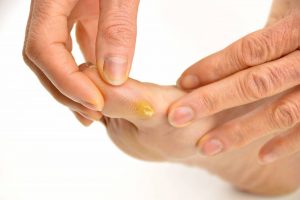
Diabetics suffer from nerve damage, which is known as neuropathy.
This often results in a lack of feeling in the feet, which can be dangerous if calluses become dry, cracked and remain unnoticed.
This can further lead to infection and skin ulceration. Flat feet cause a person to walk with an unnatural gait, which stresses an area of the foot that cannot support this abnormal tension.
Do not pick pick or pull at the skin of calluses as this will only make things worse. and often results in the ripping away of too much skin, which leaves cracks that are exposed to the air and open to the risk of infection.
Avoid sharp instruments of any kind. The following solutions provide easy home remedies to callus removal.
6 Ways To Remove A Minor Callus At Home
The experts at JAWS Podiatry advise that if a callous is not infected it can be easily removed at home in several ways with just a few easy steps.
If they are swollen or painful however, professional help is needed to both remove the callus and prevent potential complications.
The following applications are easy and safe.
- Use A Pumice Stone – Soak feet in warm water with some epsom salts to soften the skin. After 10 or 15 minutes, use a wet pumice stone in a circular motion to gently rub off the skin’s top layers. Dip feet back in the warm water, rinse several times and then dry feet thoroughly. Here is a guide to properly use a pumice stone, or purchase a Podiatrist-recommended pumice stone on Amazon.
- Urea Cream Or Ointment – Urea creams and ointments are available over the counter in diverse strengths. A cream or ointment that will soften, moisturize and exfoliate a callous will require a urea strength of 30% to 50%. Moisturizing will have better results if the cream is applied while the skin is still damp after washing or bathing. The cream will last longer if feet are covered with cotton socks after applications. For best results, apply every day and use with a pumice stone. Urea cream should be avoided if callouses are cracked or peeled.
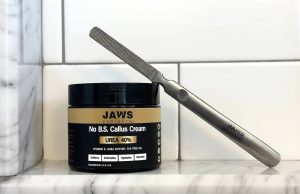
- Petroleum Jelly – We suggest that if callouses are cracked and peeling, thick petroleum jelly may well do the trick. Vaseline and Aquaphor are the two most popular brands. These ointments are safe to use every day and are most efficient when kept in place by cotton socks.
- Salicylic Acid Pads – Salicylic acid pads work by exfoliating calluses. These soft cushions are available over the counter in many sizes. The most effective pads contain 40% salicylic acid, which increases the amount of moisture in the skin and at the same time, dissolves the substances that cause the skin cells to stick together. Popular brands include: Dr Scholl’s and Curad. The pad remains in place for 48 hours, after which the callus will look whitish. Soak feet and then gently rub with a pumice stone. Apply a new pad and repeat the process for a week. The end result will make calluses feel smaller and smoother.
- Alpha Hydroxy Acid Peels – These acids also work by exfoliating skin and foot peels are highly concentrated. After use, the top layer of the callus peels away easily and softer ones become less noticeable and easier to moisturize. Effective results require soaking feet for 20 to 30 minutes in warm water, applying the peel and then leaving it in place for as long as instructions recommended .
- Shoe Pads And Inserts – These pads help relieve pressure against the inside of shoes that is particularly problematic for people suffering from hammertoes, claw toes, mallet toes, or bunions. Shoe inserts protect the heels from rubbing against the shoe’s bottom. While they do not soften or remove a callus, they can protect feet from developing new or returning ones.
Surgical Removal of A Callus
Experts warn that if the cause of a callus is not properly dealt with, it will always return to the scene of the crime and might even grow larger.
While most calluses do not require intervention, if it is caused by deformities like hammertoes or a bone that is misaligned, it may be necessary to remove it surgically to prevent repeated development.
The decision will depend on the location and severity of the callus.
A local anesthetic renders this out-patient procedure painless although some mild discomfort may follow afterwards, which can be ameliorated with over-the-counter medications.
This minimally-invasive surgical procedure involves shaving away thickened dead skin via the use of a sterile surgical blade and smoothing the edges with pumice stone.
Recovery can take a little time and depends on the specific procedure performed and other factors such as: the patient’s age, lifestyle and the depth of the callus.
Generally speaking, for best results, normal activities should be limited for 4 to 6 weeks after surgery.
Immediately after the procedure, it is advised to elevate the foot for up to 48 hours to reduce swelling, and activities should be limited to bed rest and only getting up for essential things like using the toilet, for a maximum of five–ten minutes per hour.
It is also very important to keep the foot dry until stitches are removed. Showering is possible with use of a waterproof cover over your foot.
The surgeon will provide instructions on how to treat the wound, keep it clean, and avoid infection and other complications.
In Conclusion
We are a family-run, 5-star-rated, cutting edge institute led by South Florida’s highly acclaimed founder of the MIFAS Institute (Minimally Invasive and Aesthetic Foot And Ankle Surgery), Dr. Abraham Wagner, DPM.
Our scope of offerings include many functional and cosmetic foot surgeries for toe shortening, toe lengthening, foot slimming, corn and bunion removal and more.
If you are dealing with foot pain of any kind, contact our team at JAWS Podiatry.
You may find yourself footloose and fancy-free (or at least pain-free) before you know it.
- Foot Care Tips – The Ultimate Guide To Healthy Feet - February 11, 2025
- How To Use A Pumice Stone To Remove Tough Skin - December 15, 2024
- How To Choose The Best Toenail Clippers For Seniors - August 8, 2024


